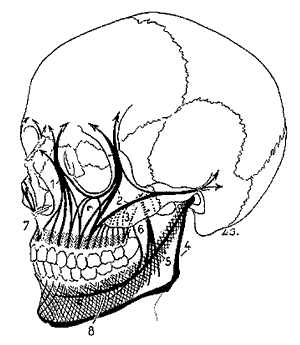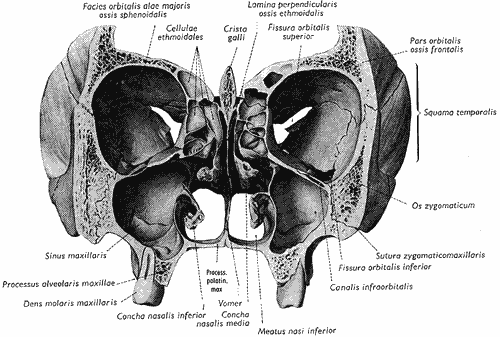

|
Journal Home Contents Preview Next |
Pro Otology
Balkan Journal of Otology & Neuro-Otology, Vol. 3, No 2—3:111—114 © 2003
All rights reserved. Published by Pro Otology Association
Some Surgical Aspects of the Management of Frontobasal Fractures
Emil Tsenev
Clinic of Ear, Nose and Throat Diseases, Central clinicum, Augsburg, Germany
ABSTRACT
Objective: Frontobasal fractures with or without laceration of the dura mater account for over two-thirds of all traumas in the frontobasal area of the scull. They pose extremely difficult problems not only for the life of the victim but also with regard to the restoration of the structure of the face. Approaches to the different lesions in fronto-basal fractures according to Escher’s classification are broadly discussed.
Study design: The study design was a retrospective case review.
Setting: Zentral clinicum-Augsburg, Germany, Clinic of Ear, Nose and Throat diseases.
Patients: The study included patients suffering from frontobasal fractures with or without laceration of the dura mater.
Main outcome measure: These included clinical development, diagnosis and therapeutic strategies to patients.
Results: According to our experience the most reliable tool in this respect is computed tomography with angiographies if utilizing extremely thin sections. It enables to obtain a clear picture of the crushed brain parenchyma.
Conclusion: The surgical techniques used for consolidating the fracture fragments and for handling dura mater defects and improved intensive care considerably increased the changes of survival and created opportunities to improve considerably the quality of live and appearance of the face of the victims.
Key Words: Frontbasal fractures, Dura mater, Skull trauma, Improved visual approaches to the lesions.
Pro Otology 2-3: 111-114, 2003
The viscerocranium has a complicated structure consisting of a strengthen bone structure, which covers the hollow spaces of the nose, the paranasal cavities and the orbit. This frame based structure rest of three points of support: 1. the frontonasal, 2. the zygomatic and 3.the palatine columns (1,2) (FIG. 1)

|
|
FIG 1. There are three points of support: 1. The frontonasal, 2. The zygomatic and 3. The palatine columns (Deneke, W. Draf-1998, I. Zenev-2003). |
Intense road traffic, violent conflicts and sports accidents provide conditions for complicated traumas involving fractures in the facial skeleton, which lead to heavy fragmentation of the structure of the frontal sinuses with or without laceration of the dura mater, the nasal pyramid and the orbit. The presents of many blood vessels in the area especially in case they are damaged, may have fatal consequences for the live of the victim.
Special problems are caused by the complex fractures involving fragmentation of the posterior wall of the frontal sinus (the dura mater is in compact adhesion with it) with laceration of the pachimenings followed by considerable liquorrhoea or haemorrhagia. All these require urgent and careful surgery, including removal of the loose fragments compressed or stuck into the brain parenchyma. This stage of the operation is important and its purpose is to reduce intracraniale pressure and terminate liquorrhoea and hemorrhage which may be the result of heavy rhinogenous complications (meningitis, pneumocele etc.).

|
|
FIG 2. The “frontal base”. |
These problems have occupied surgeons for a long time, but their detailed discussion began only in the first half of the 20 th century in connection with the increase in motor vehicle traffic (3). Later, the works of H.-G. Boenninhaus considered in detail the surgical procedure to be followed in managing frontobasal fractures with or without liquorrhoea and haemorrhagia (4). The rapid progress made in intensive care and in developing visual diagnostic tools made surgical treatment more effective and this considerably improved the chances of the patients.
The frontobasis (rhinobasis) is in close contact with the hollow space of the skull-orbit, lamina cribrosa, and nasal cavity whit paranasal sinuses. The wound of the frontal base (the frontobasal area) belongs to the big group of cerebral traumas and should always be considered a threat to live. The term “frontal base” (in the past rhino base was used instead of it) denotes the body structures of the frontal cranial cavity, which extends from the back (posterior) wall of sinus frontalis, the upper part of the frontal (anterior) and the back group of ethmoidal cells, the roof of sinus sphenoidalis, and the lateral side of the orbit (5). Laterally from crista galli there extend lamina cribrosa with many perforations which reduce considerably the resistance (stability) of the rhino base in case of traumatic impact (FIG. 2). The lateral part of rhino base passes slightly medially through the middle of the orbit. The thickness of the bony structures differs in different individuals. For instance, the zone of the orbit, lamina cribrosa, and the ethmoidal labyrinth is very thin, including even the presents of dehiscences in some cases. The posterior wall of the frontal base passes through the two canales fasciculorum opticorum and alae parve ossis sphenoidalis from where the middle cranial cavity begins. It is necessary to stress that in the area of the anterior cavity the dura mater adhered vary strongly to the surrounding bones and at that first of all in the zones of the structures and apertures of the nerves passing through the area (6).
|
|
The improved potentialities of intensive care and especially of computed tomography (CT) and of magnetic resonance imaging (MRI) have led in recent years to markedly better opportunities to achieve a visual presentation of the scale of traumatic damage (1).
The restoration of the appearance of the victim depends on the kind and character of the wound and the direction of the laceration of the skin. In undertaking this restoration we take into consideration the prospective incisions of the skin required so as to gain maximal access to the bone fragments.
We use chiefly three approaches with different modifications that take into account the above-mentioned conditions. The most frequent fractures in the frontal base area postulated by F.Escher are divided into four groups depending on the direction of the trauma-causing agent (7). The way the fracture lines have disseminated depends on the power of the agents’ impact. And still one notes that some spots are more likely to be affected with the posterior wall of sinus frontalis, lamina cribrosa, and ethmoidal cells being part of them.
In the cases of the high-placed frontobasal fractures-type 1 according to Escher (FIG. 3) - there are extensive fragmentations of the bony structures in the frontal area and laceration of the skin and of the dura mater. In the most frequent cases there is fragmentation of the anterior and posterior walls of sinus frontalis and parts of calvaria and not infrequently there occurs damage to the dura mater (FIG. 4). These fractures account for about two-thirds of all cases of multiple fractures. Because of the extensive fragmentation we use most often the skin incision after Siebenmann called “Brillenschnitt” (suture in the form of “eyeglasses”) with a possible extension vertically (FIG. 5) or even better an incision after Unterberger (FIG. 6) from ear to ear across the scalp.
The localized frontobasal fractures – type 2 according to Escher are restricted to ossal fissures and lacerations of the dura mater under minimal damage to the skin (FIG. 7) involving also lamina cribrosa, crista galli ossis ethmoidalis and the roof of the sphenoid bone. To this group belong also the most frequent iatrogenic accidents in intranasal operations.
|
|
|
The frontobasal fractures involving damage to the facial skeleton-type 3 according Escher (FIG. 8)-consist most frequently of fractures of the nasomaxillary, the nasofrontal and the nasoethmoidal complexes with a possible impression in the area of radix nasi. In the case of these traumatic lesions we use the skin incision after Killian (FIG. 9) in different variants which allow maximal access to the fractured areas.
The frontoorbital (lateral) fractures are result of mechanical forces directed laterally towards the frontal base. They are accompanied by fractures and lacerations of the dura mater with prolapse of brain matter (FIG. 10), which manifests itself clinically with orbital edema, protrusio bulbi, telecantus, pneumocelle, liquorrhoe, ect.
Diagnosing the frontobasal fractures is done chiefly by exploring lesions in the soft tissues, ascertaining bone damage by means of x-ray examinations, CT, and MRI, and investigating whether there are disturbances in eyeball motility and in the sense of smell (in case of conscious victim). According to our experience the most reliable tool in this respect is computed tomography with angiographies if utilizing extremely thin sections. It enables to obtain a clear picture of the crushed brain parenchyma (FIG. 11).
|
|
|
Our experience in the surgical treatment of frontobasal fractures permit us to draw the conclusion that imaging techniques allow the surgeon a broad access to the rhino base and the opportunity to restore the esthetic appearance of the face of the victim with only one intervention. We carried out all the operations after stabilizing the physiological indicators (cardiocirculatory) and after consulting ophthalmologists, neurologist, neurosurgeons thus ensuring an interdisciplinary approach in helping the victims.
REFERENCES
Boenninghaus H.-G. Die Behaudlug der Schächelbasis brüche Thieme 1960;2-84.
Caliceti P. Trattato di chirurgia otorhinolaryngologia. L Capelli 1941;2:235-9.
Escher F. Die Schachelbasis verletaungen Standpunkt des Otorhinolaryngologen. Ther Rsch 1974;31:147-59.
Deneke P, Draf W. Die Operationen au der NNH Schädelbasis und Orbita. Springer 1992:234-326.
Weerda H. Traumatologie der Frontobasis und Umgebung, Einschliesslich der endokraniellen Komplikationen. In: Naumann N, Kastenbauer E, Tardi J, eds. Kapf und Halschirurgie, Thieme, 1995, Bd 1, 2:458-499.
Wustrow F. Die Tumoren des Gesichtschõdels. Urban und Schwarzeinberg 1965:132-47.
Zenev I. Klinischmorphologische Rhinologie. Sofia: Drinov, 2003;26:40-181.
|
Pro Otology |
Journal Home Contents Preview Next |